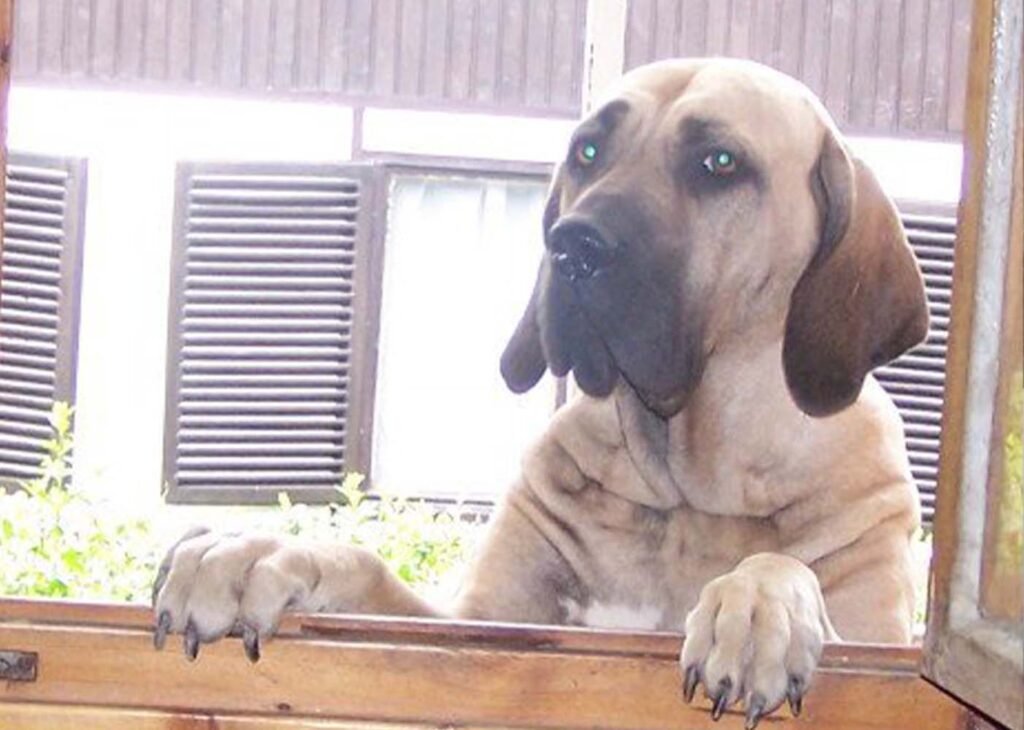Temperament and character
It is the character of the fila that sets it apart and distinguishes it from other breeds. It has a very developed protective instinct, which makes it a great guard dog. In some countries, the breed is restricted in breeding and keeping.
There is also a difference between the FCI standard and the CAFIB standard. The CAFIB describes that "due to its temperament, it does not allow the judge (stranger) to touch it at dog shows. And if he attacks the judge, such reaction should not be considered a fault, but only a confirmation of his temperament." The FCI standard has taken this out and put in that the handler must keep the dog under control, i.e., according to the FCI show rules, he is prohibited from attacking the judge. There are countless examples of dogs being disqualified for temperament.
At CAFIB events, dogs over one year of age must undergo a temperament test. The Fila's attack must be diagonally upward, in front of the handler, without showing dependence on him. Failure of the temperament test will result in disqualification.
These two sharply contradictory regulations understandably divide the filas into two camps, at least in Brazil. The Brazilians, who want to preserve the temperament of the Fila and only participate in events that follow the breed-specific CAFIB ideology, say that the Fila has no business in a beauty show that goes against the breed's basic appearance and character.

The character of the fila is dipolar, they accepts those it meets as a puppy, it is not a little in love with its owner, but it can be aggressive or even aggressive towards strangers. This is called "orejiza".
Even at this age, a two-month-old fila puppy is often dismissive of strangers, simply shying away or hiding under a bush, or growling to express displeasure. On one occasion when I was looking at puppies, an elderly couple came to me and said that they had always had a Fila and would like to have one now. I was happy for them, thinking that I didn't need to explain much about the breed to them as they knew it. Since I couldn't let them in to see the puppies in one place because of the adults' unfriendly attitude to strangers, I brought out the 3-month-old puppy to show them who was a potential candidate. Or should have been, because when he saw the two strangers, he tore himself out of my arms and ran away. I triumphantly brought the puppy back to them, waiting for the acknowledgement that this was the real puppy with the character of a fila, not wanting to make friends. To my surprise, the exact opposite happened, they were completely shocked that none of their filas were like this and they didn't like this behaviour and didn't want such a shy puppy. Afterwards I could have told them anything, that this is often the case with fila puppies, because it is a breed trait and this is what later develops into a fierce dislike of strangers. At this age it is still the budding manifestation of their later nature and how do they not know this if they know the breed. It is better that it turned out this way, because it is not fit for people to have specimens of the true Fila nature in their hands, who do not even bother to get to know the breed.
But let's look at the character of an adult fila, because by this time it can be assumed that it is already established. Anything from tolerance of the presence of a stranger to intense aggression can be shown, even in the same dog, for the rest of his life. This is because they are individuals, each one is different and cannot be put into a set of rules as to exactly how they should be. What we can expect is that they will respond to an attack with an attack and to a friendly approach from a stranger with a rejection or at least restraint. The degree of arrogance with which he responds to this approach is for him to decide, in his judgement. Of course, our upbringing also has an influence and the fila always wants to please its master. Therefore, his upbringing is very easy and he should never be treated too harshly, because too strict an upbringing from his owner can take a very serious psychological toll. This is not necessary, he will learn the rules easily and quickly, provided of course that he has an owner who knows the basic rules of dog training.
Even with very little socialisation, a really well-behaved fila will walk confidently around people and dogs. He is not disturbed by strange noises. He listens, shows interest, but doesn't tuck his tail between his legs and jump because he's scared. In large crowds he can shut out his surroundings and only listen to his owner. This behaviour changes to the opposite when we walk him in an area where there are no people. In this case, if someone appears in the distance, he will follow him with his eyes for a long time, considering it an immediate emergency and often reacting with growling. This is exactly the behaviour of the fila in the video.
He follows his owner wherever he goes and even his first trip in the car doesn't make him restless. The fila in the picture was 3 years old when she first sat in the car and is visibly happy to be with her owner.
A very well-nerved fila will have these qualities, but if a young dog is not yet fully confident, that can change. On the other hand, a frightened, out-of-the-world feral who is more afraid than confident in his owner is not desirable behaviour.

A fila's distrust and suspicion increase as the day turns to twilight. He becomes more barky and more aware of his surroundings. This distrust can even be observed when we move our fila, used to urban noise, to a much quieter, less populated area.
Fila does not have a fierce pack leadership role between dog and man. He needs to be shown what is good and what is bad behaviour, but he never wants to get the upper hand. He has only one clear purpose with his owner, and that is to be near him. He can often be a problem if, sooner or later, he realises that he can not only look out of the window, but also look in.



They are very friendly with the children in the family and tolerates everything from them, but this is not true for strange children, so we have to be careful.
They not good for grazing, which means it needs a close relationship with its owner and regular care. Not comparable to Russian Shepherds, who can do with less time with their owners.
Köszönet a fenti képért Claudio Rufino-nak.
